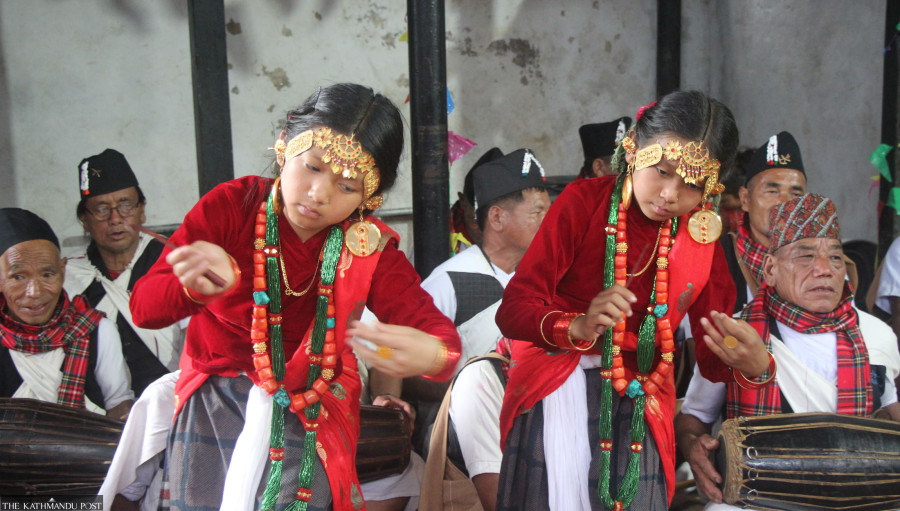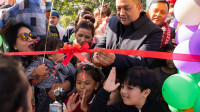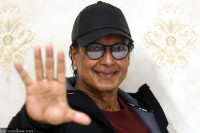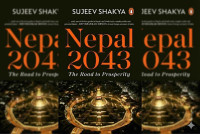Culture & Lifestyle
The story behind Ghatu Nach
The dance follows an expressive performance depicting various aspects of people’s lives, including births, duties, animal husbandry, agriculture, and more.
Aash Gurung
Eleven-year-old Nukashi Gurung and twelve-year-old Ankita Gurung dance gracefully to the melody produced by their teachers playing the harmonium and madal—both dressed in Gurung attire. These dancers are called Ghatuni.
A fifth grader, Riya Gurung eagerly waits for her turn to dance. The dance instructors, Indra Koshi Gurung and Muna Gurung assist the dancers with their performance, often adjusting their traditional gunyu cholo attire. During the dance, the dancers' hand, leg, and body movements are perfectly synchronised. The exact origins of the practice are unknown. Some say it dates back to the 15th century, while others believe it began in the 17th century.
Indra Koshi and Gurung learned the Ghatu dance in Kwholasothar, a tourist village in rural municipality-4, Bhujung. To keep the tradition alive, the villagers have started an initiative to teach the Ghatu dance to the new generation.
This dance, accompanied by songs and the tune of the madal, takes place annually on Baisakh Purnima, also known as Ghatu Purnima in Bhujung. Tourists from all over the world come to witness the performance on Baisakh 10.
The practice, characterised by complete body movement in harmony with song and madal, is a traditional lyrical poem with unique melodies and rhythms.
“At first, it was difficult to perform the Ghatu dance because it hurt my waist and legs. However, with time, I got used to it. I don’t feel the pain anymore,” says Ankita Gurung.
According to Guru Buddhiras Gurung, girls who have not yet started menstruating are chosen to perform the Ghatu dance. Out of the two dancers, one symbolises the medieval King Parshuram and the other symbolises Queen Hyomaudi.
“Those who have started menstruating, have cut their hair, or have wounds on their bodies cannot perform Ghatu as Ghatu will not possess them,” says Budhiras Gurung.
The locals believe that dancers who have body wounds or are bitten by snakes and dogs are not possessed by the Ghatu spirits. Among the chosen girls, those who receive their Ghatu first are made to be kings. Alongside the melody of the song, the dancers click their fingers and sway their waists. They dance while standing, sitting, and even lying down.
The song progresses with the practice of worshipping, putting tika, and wearing pagari. Friends of the Ghatu dancers are selected to take care of the dance during their performance.
According to Ghatu Guru Birlal Gurung, the Ghatu dance on shree panchami begins with preparing the dancers by making them bathe and cut their fingernails. Then they get adorned with the traditional gunyu cholo attire.
The themes of the Ghatu dance revolve around the marriage, love, lifestyle, and hunting of the medieval King Parshuram and Queen Hyomaudi. The dance follows an expressive performance depicting various aspects of people’s lives, including births, duties, animal husbandry, agriculture, and more.
According to the story, the medieval king and queen get married and fall deeply in love. Their story turns tragic when a neighbouring king attacks their kingdom.
King Parshuram goes to the battle to save his kingdom but succumbs. After the king’s death, the queen prepares to commit sati, leaving her infant baby behind despite everyone's protests.
There are two types of Ghatu, namely, barhamaase and sati. A later development considers kusunda another type of Ghatu. Those who can dance for 12 months are called barhamaase, while those who start dancing at the beginning of the month of Maagh and end on Baisakh Purnima are known as sati.
The concept of kusunda is based on the story of the queen who goes to commit sati but she is not burned by the fire. Instead, she becomes Kusunda and enters the jungle. To lighten the sombre moments of the Ghatu dance, it is common in the villages to crack jokes to keep the dancers in a pleasant mood.
According to culturalist Professor Jagman Gurung, the character of Ghatu is based on King Pratap Shah.
Kalu Shah’s wife became a widow after his death. Kalu Singh was supposed to be crowned king, but his premature death left his pregnant wife a widow. Kalu Shah's brother, Yasobramha Shah, then began taking care of his sister-in-law.
She later gave birth to Pratap Shah, who was given the kingdom of Ilampokhari. Pratap Shah died in battle on the banks of the Marsyangdi and Bhalaamkhola rivers.
According to culturalist and researcher, DB Gurung, the story of Ghatu is based on the life story of the last king of the Gurung community, King Khyaalbo and Queen Yamawati.
Though there are different mythologies about the story of Ghatu, the prevalent Ghatu is solely based on the life story of King Parsuram and Queen Yamfawati.
According to Narayan Gurung, the ward chairperson of Bujhung, Bujhung organises a mela every year on Baisakh Purnima to see the Ghatu Dance, which reflects Nepali culture and society. Guests and tourists are welcomed with a mixture of wheat and curd.




 7.12°C Kathmandu
7.12°C Kathmandu.jpg)















